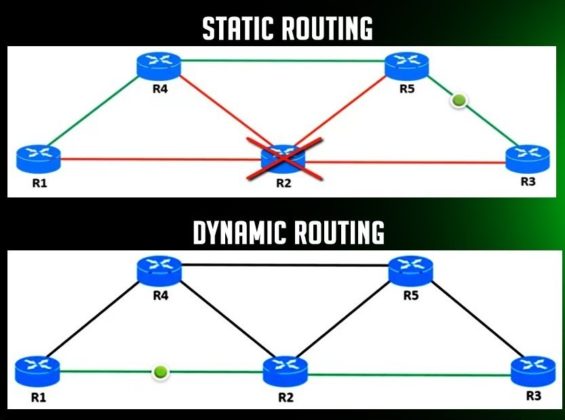Before explaining static and dynamic routing, we have to understand what is routing? Routing is the process of sending or transferring packets from one network to another and these packets are delivered to the hosts in networking.
The things that should know by the router while routing includes,
⦁ Address of destination device.
⦁ Neighbour routers(to know about remote networks).
⦁ Best rote that having the shortest path to other remote networks.
⦁ Details about how the data maintained.
⦁ All possible routes.
In networking, there are multiple types of routing algorithms they all are grouped or classified based on modification that happened to the routing table. The two important them are,
- Static routing
- Dynamic routing

Static routing is happening when we statically configure a router to send traffic for a particular destination. This happens in a preconfigured directions.
What paths traffic should take can find out by using a routing protocol such as IS-IS, OSPF, EIGRP, and/ or BGP, and this can be called as Dynamic routing.
One of the dynamic protocol called OSPF can determine the best routes within an enterprise by a typical network. The best exit points to the rest of the internet can be determined by using one of the protocol called BGP(Border Gateway Protocol). These all together can be combined with reasonable default routes by using the static routing.
Static routing systems cannot respond to any change that happened in the network. So, all the routing decisions created does not depend on the traffic or topology. And the advantage of this is that, therefore, it does not require any additional resources. Because of all these reasons, we cannot use static routing if the network changes always or it is large. Another name od Static routing is non-adaptive routing.
Also read…
Dynamic routing is the best routing technique, because, it changes the information in the routing table dynamically according to any changes that happened in the current network. When a change has happened in a network, the network sends a message to the router that contains the message that a change has occurred, recalculate the routes and then sent this message as a new routing update message. According to this message, the routing table is updated correspondingly. Another name of dynamic routing is adaptive routing.
In static routing, all the modification to the routing table is modified manually. But in the case of dynamic routing, this modification happens automatically to the routing table.
Dynamic routing is more suitable than static, because, we cannot recover the systems if any failure happens, in static routing. This is why we say that dynamic routing overcomes all the limitations in the static routing.
In static routing, we have to type the routing locations by hand to the routing table. But in the case of dynamic routing, it is simplified by filling this location dynamically in the routing table.
Any failure affected by the link stops the rerouting, in static routing. This demerit can be overcome in dynamic routing, because, it does not affect the rerouting process if any failure happens to the link.
Download Static Routing and Dynamic Routing in pdf – Click here
